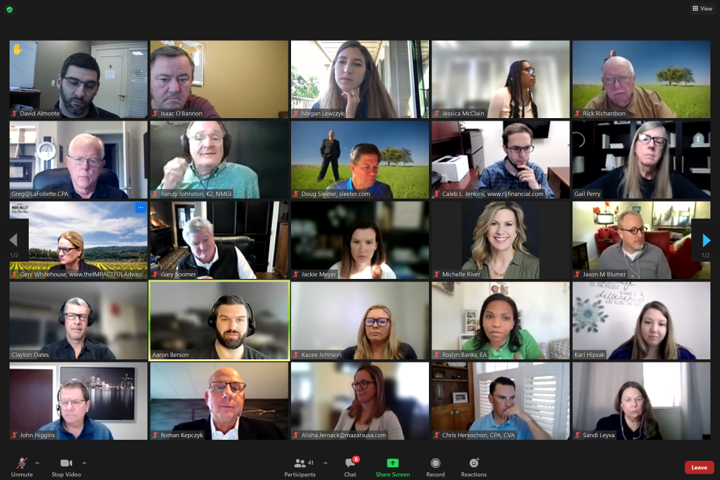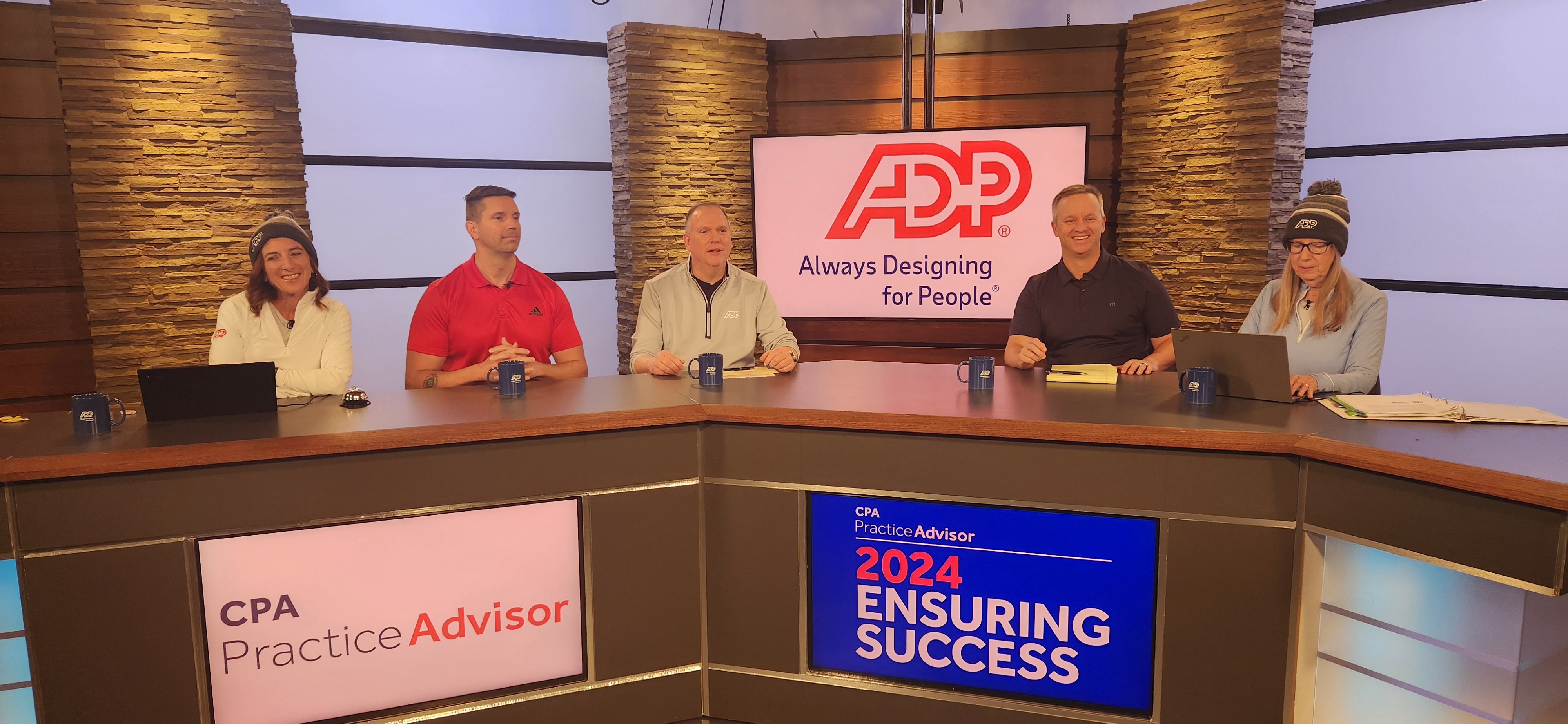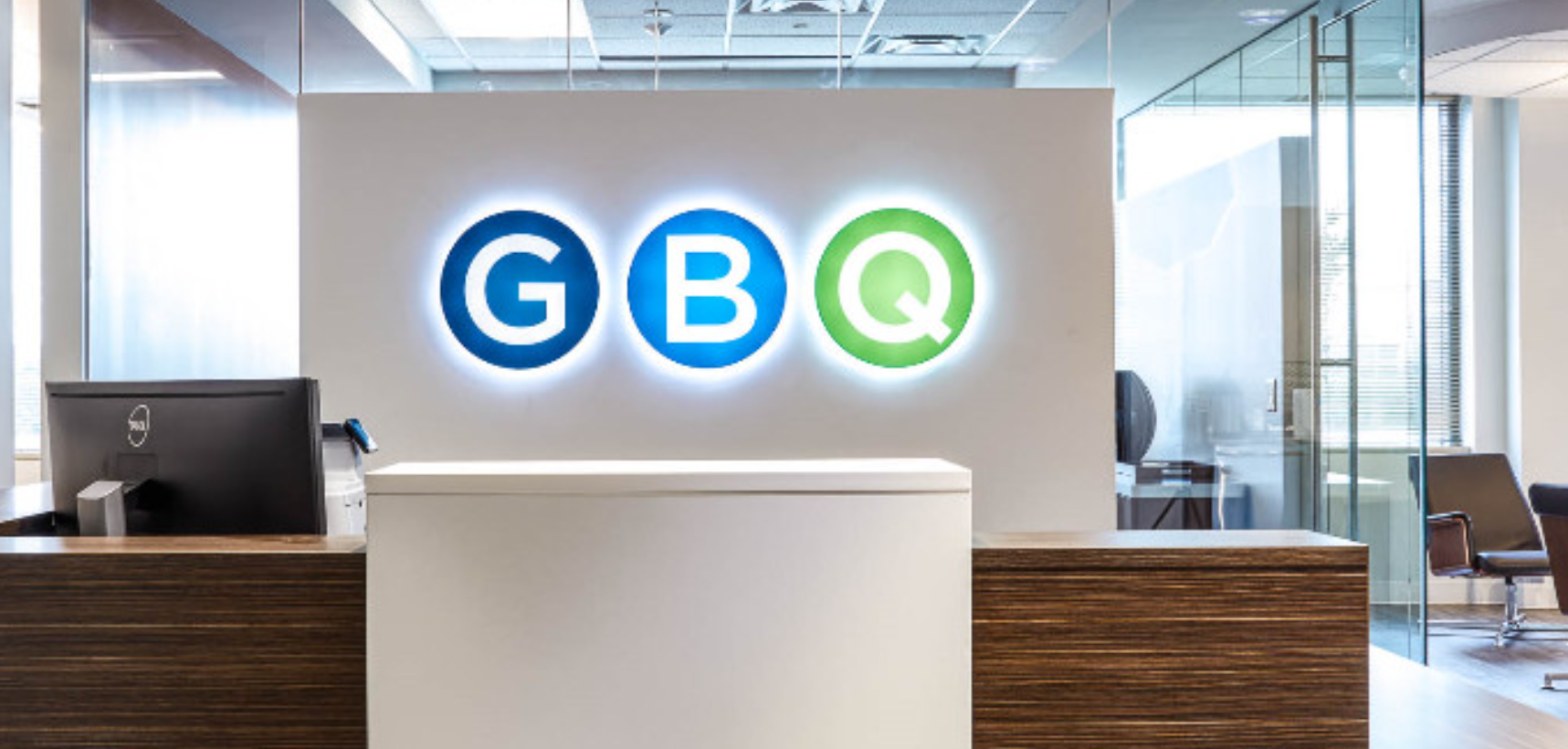Accounting professionals are now more efficient, more productive and more accurate than ever before. But with the continual advance of the technologies that have made this progress possible, has come a corresponding pressure for firms to adapt in other ways, forcing the evolution of workflows and practices overall. With the confluence of multiple shifts, including the rise of AI and automation, generational change in firms, and increasing staffing challenges, firms are also facing increased client demand for advisory services and outside infusions of capital that help drive them toward future growth and success.
In April 2024, thought leaders from tax, accounting, education and media convened virtually for an Accounting Meta Influencers roundtable focused on business model transformation, as firms are looking to expand and compete, do more for clients, and evolve into a new era.
The Accounting Meta Influencers discussion is held quarterly, and is hosted by Avalara, focusing on significant trends and issues facing the profession. Previous topics have included:
- The Present & Future of CAS for Accounting Firms
- The Real Impact of AI on Accounting
- What Private Equity Means for the Profession
- Firm Workplace Best Practices
- Top Trends Impacting Firms
- How Firms Can Adopt or Optimize Advisory Services
The discussion began with an introduction by moderator Dan Hood, the editor-in-chief of Accounting Today, who told participants that the objective of these roundtable discussions is to provide actionable insights to firms, including practical tips and strategies to help professionals tackle the big issues they face. He also noted that a special guest would be joining in the discussion on business model transformation, Rob Brown, founder of U.K.-based Accounting Influencers.
Jennifer Wilson joined in to provide a backgrounder on the concept of business transformation as it relates to accounting firms. Wilson is cofounder and partner with Convergence Coaching, which helps develop leaders and provides management and strategic planning consulting to firms. Wilson has been a participant in all of the previous roundtable discussions, and opened by noting that when she and Hood had initially planned for this topic, they realized they each approached business model transformation from different perspectives. As a result, she described three planes or levels they had identified out of their conversation to use as a guide for the roundtable discussion:
Levels of Business Model Transformation
- Ownership and Guidance – This level involves ownership or equity structure, merger and acquisition strategies, ESOP, service lines, and revision of partner compensation arrangements.
- Management Structure and Culture – This level goes into detail on firm decision-making Use of outsourcing or offshoring will continue to pick up pace, especially in areas like audit, accounting and tax, leading to increase billable hours.processes and resource management, including empowering managing partners, as well as leaders over service lines, industry groups, and operations.
- Business Model Elements – This plane covers talent programs and policies, including nontraditional, remote learning and development, pricing, client niches, increased client selectivity, KPIs and technology.
“There has been a lot of merger and acquisition activity that’s really changing the face of the top firms, the top 16 of which are over a billion in revenues now,” Wilson said. She noted that even to be in the top 100 firms, there is about a $50 million threshold, which has been fueled by M&A activity, not organic growth.
“This has really started to change the face of the way that these organizations are owned, governed and managed,” she added, and that employee stock ownership plans (ESOPs) are becoming more common in firms, further adding to changes in the structure of service lines and partner compensation.
These changes in ownership structure have changed how decisions are made at the highest level, but there have also been changes in strategy and structure decisions on a more operational level, Wilson said. These factors are influenced by how managing partners and firm leaders are empowered, as well as recognizing non-CPA business professionals as critical leaders within firms. “In the old model, partners could act autonomously, feeling they did not need to report to anyone.”
“But as the evolution of the business model grows, you can’t sort of run every person or partner for themselves. You start to organize under a singular management structure.” ~ Jennifer Wilson.
Wilson summed up her opening definition by noting that these ongoing changes to business management in firms are affecting and being affected by staffing and pipeline issues.
Hood then reengaged the participants, noting, “It’s interesting how intertwined all these things are. How change at every level either flows upward or downward.” That even decisions about onboarding processes can flow all the way up to decisions about management structure and ownership.
Changes to Firm Governance Structure
The participants were then asked, “What should firms be thinking about when making substantive changes to their business model,” considering a lot of these ownership issues such as ESOPs, private equity, M&As by wealth management groups or RIAs? “We think this is a pretty big issue,” Hood said, “because we’re seeing a lot more firms get involved in this, or they are seeing other firms who are considering … [ownership structure changes].”
“We’ve had a lot of activity in this area, including Eisner and Cherry Baekert, two of the larger consolidators in PE, as well as smaller firms engaged here in our organization,” said Mark Koziel, CPA, president and CEO of Allinial Global, an association of independent accounting and advisory firms. He previously served as a VP at the AICPA.
“It’s happening in the U.S., Netherlands, Italy, and Australia, we have a number of firms around the world that are doing this,” Koziel added, noting that firms frequently ask their advice on what they should do with regard to ownership structure changes like PE.
“It’s the governance that we need to fix first before we do anything else.” ~ Mark Koziel, CPA.
His opinion is that the issue is going to come to a head when senior and retired partners push back against some of these changes. “Koziel said he has advised many of those firm partners, “Look, you don’t have to sell out to PE, you don’t need to create an ESOP. Just create a phantom stock plan, and understand that the value of your firm isn’t everything you can rip out of it every year. That’s what needs to change.” Koziel also advocates for removing the term managing partner and replacing it with CEO, since partners are averse to being managed, and the role of this person is not to manage partners, but to lead the firm.
“Making these changes better positions you for the future…and makes your firm even more attractive to PE or other investment opportunities,” Koziel said.
Hood agreed, suggesting that the traditional partnership structure is a key challenge facing firms because partner disagreements may prevent the firm from making the other changes they need to make, from staffing to service lines. “How nimble can a firm be, who can make the decisions? If it’s a managing partner, they’re going to have less ability to do that than a CEO.”
These issues can arise in firms of any size, and are certainly prevalent in larger ones, but Hood noted that firms starting in the $5-10 million range, with approximately 20 partners, is a general threshold for when the issues become more critical to address. “You start needing to make decisions that you can’t make if every partner has an equal vote,” Hood asserted.
Preserving Firm Culture
“I really think that if you don’t have a strong commitment to your [firm’s] culture, when you’re trying to figure out what to do about the ownership and governance, you risk losing that culture,” said Diane Yetter, CPA, president and founder of YETTER Tax, and founder of the Sales Tax Institute. “Because when you’re going to look for somebody to partner with in terms of private equity, or in terms of other ownership changes, if they don’t understand your values and culture, you risk losing that if you’re not matching the same culture.”
“The question is, whether or not a firm’s familial culture is sustainable in today’s world,” said Yvonne Scott, CPA, the CEO of the consultancy CIO Concierge. “One of the struggles that firms are going through is: ‘Well, we indoctrinated you into a partnership with the concept that you’re a business owner, and that as such, you get to be a part of decisions.”
Another issue Scott noted is that in many firms with a CEO or similar role leader, that person still has to report to someone, in some cases a select “group of partners elected by other partners, and it becomes political, and the concept of outside directors for accounting firms is probably past its prime.”
“As we revisit the whole governance model, we have to think about where are CEOs and leaders getting advice, counsel and guidance, and who are they accountable to?” ~ Yvonne Scott, CPA
“Even now with my firm at 36 employees, I’m still technically the only partner or owner,” said Donny Shimamoto, CPA, the founder of IntrapriseTechKnowlogies and the Center for Accounting Transformation. “We’ve built a culture of trust. We’re entrusting the right people to make the right decisions. And to do that, you do have to have the right governance structure. The corporate culture is direction, and even though I’m the only owner, I have two other directors.” For top level firm management decisions, the three discuss and reach agreement or vote on the decisions. Although Shimamoto notes that, “in the end, I probably do have a veto if I really wanted to, but that would break their trust. Would they continue to stay with me and the firm if I did that? Probably not.”
Ownership structure shouldn’t change the process of the firm decision makers seeking input from various sources within and outside the firm, noted Jen Wilson. The leadership body needs to continually be learning and listening and asking before implementing actions, because they don’t know it all. “We have to be careful of this idea that ownership structure changes that. It shouldn’t change that.” There needs to be an inclusivity of people in the decision process, she said. But the current partnership model allows a single person to put up a roadblock, which hamstrings the organization.
Regardless of the legal and ownership structure of a firm, it’s still critical to incentivize and respect the people who are doing the work that benefits the firm and them, said Geni Whitehouse, CPA, an author, consultant, and current president of the Information Technology Alliance.
“You can call yourself whatever entity form you want, but it’s, ‘How do we make this business that we’re in really function’ in a way that serves all of its members and its clients more effectively and better … It’s this traditional thinking that isn’t serving us anymore.” ~ Geni Whitehouse, CPA
Hood responded by challenging the group to revisit the goal of firms. “What’s the point of why people are making all these changes? I think we know it’s because they want to retire and want the money.” He also suggested, however, that outgoing firm leaders also want to see positive change, “further down the line, in the experience for Gen Z” staff. He then challenged Rob Brown for his opinion on the topic.
“The firms that we work with and speak to are likely the most progressive, agile firms around,” said Brown. “So, we’re getting a skewed view here. The accounting profession as a whole is very glacial in the way that it changes.”
“The profession is very slow to adapt and there are very few things that spur rapid change beyond mandatory tax regulations and legal requirements.” ~ Rob Brown.
Out With the Old Guard?
“There is an appetite to preserve the status quo. The stakeholders want to keep things as is,” Brown added. “They’re clinging on to the partnership model because it’s served them very well. But what’s clear with the generation coming through is they will not tolerate the status quo. They’re either going to get out or they’re going to drive change from above.”
Brown noted that young professionals want to change the model of professional firms, but senior professionals are averse to change unless it is forced upon them.
Hood agreed with this premise, asserting that two firm “pain points are driving the evolution: Retirement of firm partners, and the talent issue, which is tied to retirement but also has other immediate problems in terms of capacity … if you want to bring the next generation on, you’re gonna have to make some significant changes. That will require a lot of effort on your part and a lot of change.”
Yvonne Scott interjected: “What I would say is that there needs to be a way to transition people who bought into a model with an expectation of what that meant for them and their livelihood and how they conduct their lives, and now they’re approaching the end of their careers. They’re not willing to just lay down and say, ‘Okay, it’s a new day. I think I’ll operate differently,’ because they’ve built a life around this. So how do you transition people from that old model?”
A New Generation
Another factor impacting firm evolution, the talent pipeline, and traditional firms moving toward new ownership models is a generational change toward earlier entrepreneurship, said Nayo Carter-Gray, EA, the owner of 1st Step Accounting.
“One thing that I am noticing is that the younger generation are even trying to bypass the whole ‘working for somebody else’ piece,” Carter-Gray said. “And so, when we talk about owners, some of them are coming out of college and saying, ‘I’m going to own my own firm,’ without even having the idea that they need to go work for someone else. So, even as we have this discussion about what this is going to look like in the future, there’s going to be a huge gap of people skipping the traditional model of going to work at a large firm, and instead are starting their own thing.”
She further suggested that this would result in a surge in micro firms and solo businesses, because the idea of working in the traditional firm model is not sexy enough.
Irfan Dossani said he doubts most of the incoming generation of professionals think of the ownership structure of a profession before going into it. A CPA, ITA board member and partner at Whitley Penn, Dossani said he thinks they are more likely to think about flexibility. He suggested firms need to consider shorter-term partnership paths as a segue from the current status quo.
“The concept of careers is dwindling … Maybe a transition plan of, you know, the new people that are coming on board go through a five to 10 year transition to a new trans-partnership model or ownership model, and let the partnership model kind of go away and let the new one come in,” he said. “But I don’t think it’s ownership. Ultimately, I find it hard to believe that the next two or three generations are really going to care about ownership; they’re really going to care about purpose more.“
Compensation
Shayna Chapman, principal of Shaynaco, a firm in southern Ohio, said she is recognizing the complexity of the situation as a whole.
“There’s just so much happening here. One of my first thoughts back when we were talking about the bigger firms and the ESOPs and stock plant was that we were also talking about PE, and I was thinking to myself, ‘Do they really even care about culture?’ And then we got into the younger generation not wanting to be a staff accountant … And they see firms outsourcing work to other countries. Does it help people at the bottom if we’re outsourcing? They’re leaving because they want to be appreciated and they want their own money.”
“This conversation feels to me like quantum computing,” said Randy Johnston, founder of Network Management Group International and a shareholder in K2 Enterprises. If you don’t know much about quantum, in geometry, the shortest distance between two points is a straight line. That’s not the way it works in quantum. The [shortest] distance between two points is an infinite number of paths. Those getting degrees now and trying to get into the profession … the job they have today and their future job may be wildly different.” Johnston also opined that it is difficult to get some partners to adjust compensation upward unless it is tied to performance factors that also increase their own potential income.
“There is nothing sexy about being underpaid or not being paid enough.” ~ Nicole Davis..
“One point Jen [Wilson] made was that greed is a significant factor preventing change,” noted Sona Akmakjian, CPA, global head of strategic accounting partnerships for Avalara. If the people deciding on structural, technology and staff changes are greedy, they may not want to invest capital in longer-term goals. “Why invest in big technology? Why change the process when it’s going to impact your pocket personally? So, I think the decision making process within these firms needs to change so that they can drive the change the profession needs.”
Nicole Davis, founder and principal at Butler–Davis Tax & Accounting, LLC, said that change from even small firms can permeate upwards into the top firms, if they have open-minded leadership. “I’m a very small firm, and a top 40 firm reached out to me and asked me to consult on how to be more innovative,” she said. “They have so much red tape and so many things they have to check off and get approval for. But having that person be willing to even step out and note that they want to change is big. They just need someone to help them do that. I think that’s where we can have the most impact.
“This is definitely the issue we need to solve for but this has been a problem for decades,” Davis continued. “And we’re not the first ones who’ve tried to solve it. So, we need to go back in and throw some things against the wall to see what sticks. That’s how we’re going to move forward and get these other firms to be more willing to change and transform.”
Peter Wen, CPA, the founder and CEO of Tallyfor, compared the ongoing transformation of the professional firm model to prehistoric times. “You’ve got dinosaurs that have been around forever fighting for food, while their world changes. And it can change quickly or slowly. But there’s a new life here, the new firm models are the mammals, and they’re adapting. As a tech guy, I feel that tech is one of the vectors driving why this is changing.” In other words, firms that adapt will thrive in the new paradigm, while those who stagnate may meet the same fate as the dinosaurs.
“What I’m seeing as a positive is that there are managers and staff and young partners leaving private equity firms in droves because they’re very unhappy,” said Amy Vetter, CPA, CGMA, CEO of The B3 Method Institute and Drishtiq Yoga. “So, some firms are noticing, and seeing that as an acquisition of staff where they’ve got the upper hand and are actually changing their culture. Many staff, managers, senior managers, young partners are coming over, and never want to be in a private equity situation again, now that they’ve lived it. And they’re looking for firms that are privately owned, so it does become its own superpower — if they can take advantage of it in the right way.”
Also participating in the roundtable discussion were:
- Gail Perry, CPA, editor-in-chief of CPA Practice Advisor.
- Michael Hsu, a CPA and the founder of DeepSky, one of the first outsourced accounting service companies. He then founded and is currently CEO of CFO Club.
- Jenni M. Huotari, CPA, partner and business outsourcing practice leader at Eide Bailly.
Thanks for reading CPA Practice Advisor!
Subscribe Already registered? Log In
Need more information? Read the FAQs
Tags: Firm Management, Technology




